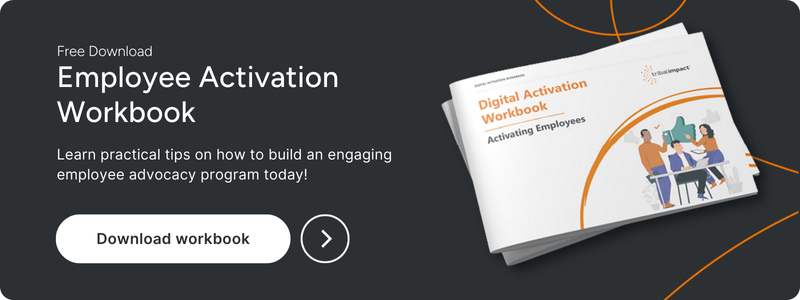‘I mastered the art of rubbing two pennies together and making it look like $100,’ said Purna Virji in a recent LinkedIn Live with us.
Purna is an author and principal consultant at LinkedIn. She’s a multi-passionate individual with a degree in journalism and has always liked writing and telling stories.
In her book High-Impact Content Marketing: Strategies to Make Your Content Intentional, Engaging and Effective, she teaches others how to get the most from their content.
We spoke to her about how you can elevate your content strategy through employee advocacy.
Read on for a summary or check out the interview replay on LinkedIn or on our podcast below.
What Is High-Impact Content?
Purna defines high-impact content as content that provides value for you and your audience. It drives business needs and audience outcomes, goals, and desires.It’s about getting off the content-creation treadmill and rethinking your approach to content to create something that’s timeless and valuable.
Focus on sharing content that empowers, educates, and uplifts audiences. Do a handful of things well instead of trying to do everything.
Does Thought Leadership Require A Separate Content Strategy?
Purna reassured listeners by saying that you can infuse thought leadership into your existing content strategy.
She shared this great analogy from her co-worker, Fernanda - Gurgel which says ‘If you think of content strategy as a house, thought leadership should be one of the load-bearing walls.” It’s one key, essential element of your strategy.
Not everything has to come from the company voice. Can your employees:
- Amplify something?
- Expand on it?
- Give it a personal touch?
Purna gave the example of Samsung at the past CES event. They had a post on LinkedIn from the point of view of a product manager who built it, and how they approached that build. The post was compelling because it provided a human-interest angle to a product overview.. It was a win-win scenario because it built their talent brand and promoted their product.
Microsoft does this too. In one of their blogs, they had a feature about AI and how the people who built those products use it to be more creative and efficient at work.
These examples show how people can amplify and make the brand message more relatable.
Where Should You Start Your Thought Leadership Strategy?
Purna would start by investing in salespeople as sales cycles are getting longer.
Recent research suggests that it in B2B a buying committee consists of as many as 11 involved in making the purchase decision. And 49% of decision-makers say that thought leadership influences their decision-making.
Purna also explained that we filter more things out because, ‘The tolerance for mediocrity is dwindling.’
Content from different people within the company talks to people within the buying committee in different ways.
The Differences Between Company Content And Employee Content
Purna used a recent Semrush product launch as an example of different content approaches.Semrush’s post to their company page used a humorous image and had around 600 engagements.
The same day, the VP of brand marketing posted about the launch from her POV. She detailed how it was created, what it can do, and what she’s seen as an executive. This added a different context to the conversation.
Her post had a similar number of reactions, along with 83+ comments in the first week alone. People were more willing to ask her questions and engage in dialogue with a person.
And, when someone comments on a post, their network sees it in their feed, too. So it further amplified the post’s reach.
The influencer marketing lead did another post on the same topic but approached it from a more tactical, day-to-day, end-user approach. This also got a lot of reactions and comments.
All these post types came from one idea: promoting a new product.
What Company Goals Does Employee Advocacy Help You Achieve
Purna listed management, reach, and affinity.People are often worried to post because they’re afraid of what people will think, but she shared this valuable advice: Be less worried about what people think about you and worry about if people think about you at all.
You want to make sure you’re an option. And you do that by building trust so that when someone does need to make a decision, they think of you.
Include Thought Leadership In Your Content Strategy
Embracing employee advocacy doesn’t mean you have to overhaul your existing content strategy.
Instead, it complements it, expanding your content’s reach and allowing you to approach it from multiple angles. So then you reach more decision makers and answer more questions before they speak to a salesperson. All helping shrink the buying cycle.
Need help growing your thought leadership on LinkedIn? Get in touch today to find out how we can help.

